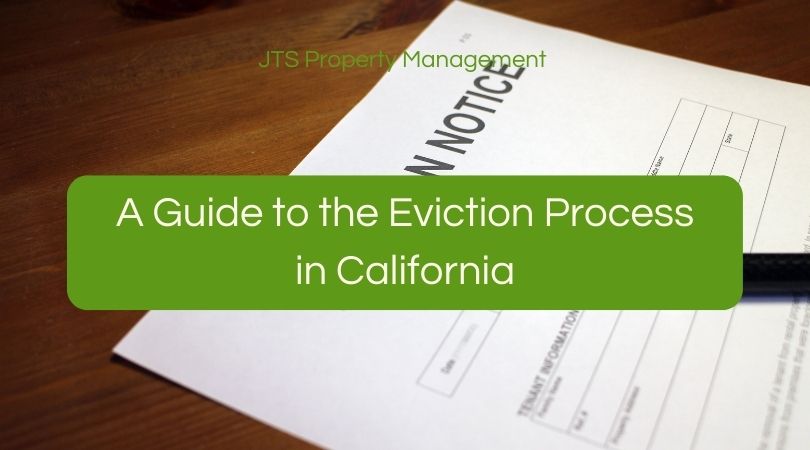Are you a landlord wondering how the California eviction process works? Not sure what your responsibilities are during an eviction or how to serve one? Read on for our step-by-step guide through the entire process.
California eviction laws allow landlords to carry out evictions against tenants for certain reasons, such as when the tenant fails to pay rent owed, breaches the terms of the lease agreement, or stays after the lease or rental agreement has expired.
Generally speaking, an eviction takes roughly 5 to 8 weeks for a landlord and their tenants. However, the lease termination process can take much longer if tenants contest their removal or files a complaint.
It's important to note that a court order is a prerequisite for the successful eviction of a tenant. As a landlord, you cannot try to forcefully end a tenancy by any other means, such as shutting down their utilities, locking them out, or removing the tenant's belongings.
The California eviction lawsuit must also be founded on legitimate reasons, and not for retaliatory or discriminatory motives. You can read more about examples of discrimination in our Fair Housing article.
The following is a basic overview of the eviction process under California law.
Legal Grounds to Evict Tenants in California
It goes without saying that a landlord must have a legal reason in order to evict tenants from their rental premises. The legal reasons to prematurely end a tenancy are as follows.
- Unpaid rent
- Absence of a lease/ expiry of a lease or rental agreement
- Violation or breach of the lease agreement
- Illegal activity

Once landlords have a legal reason, they must then follow a specific eviction process to evict the tenant.
Notice of Eviction in California
Under California eviction law, landlords must terminate the lease agreement by serving the tenant with an eviction warning. A landlord must serve the tenant with a proper notice for the eviction to be successful.
To end a tenancy and remove a tenant for nonpayment of rent, the landlord must serve them with a 3 days notice to pay rent or quit. This notice will allow the tenant to either pay the past-due rent within 3 days or move out. The landlord can continue with the eviction if the tenant doesn’t pay rent and continues to occupy the rental unit after the notice expires.
Evicting a tenant who doesn’t have a lease agreement or one whose one has expired, the landlord must serve them either a 30 or 60 days notice. If the tenant has occupied the rental unit for less than a year, you must serve them a 30 days notice.
And if they have occupied the property for more than a year, the landlord must serve them a 60 days notice.
Unlike some other notices, eviction notices don’t give the tenant an option to cure a violation prior to evicting. Their only option is to leave. If the notice expires and the tenant hasn’t left, the landlord can move to court for further help with the eviction process.

To evict a tenant for a lease violation, the landlord must provide the tenants 3 days to cure or 3 days’ to quit notice. The 3 days to cure applies to violations that are curable. Such as, failing to keep the rental unit sanitary, having unauthorized pets, or using the property for wrongful purposes.
If the tenant stops or rectifies the violation within 3 days, landlords must cease further eviction proceedings against them. However, if they don’t, landlords can escalate the matter to a relevant court.
The 3 days notice to quit, on the other hand, applies to violations that can’t be cured. A good example of such a violation is where the tenant causes excessive property damage that cannot be remedied by the security deposit alone.
To evict a tenant for engaging in illegal activity, landlords must give them a 3 days notice to quit before proceeding with their eviction. In California, illegal activity includes unlawful business activity, criminal threats, and criminal nuisances.
If the notice expires and the tenant is still occupying their rented premises, you can move to court and file for their eviction and have them vacate the property.
You can deliver the notice in either of the following ways.
- In person
- Leaving a notice with an adult occupant AND mailing a copy to the tenant
- Posting the notice in a prominent area on the property like on the front door, and then mailing a copy to the tenant through registered mail

Unlawful Detainer in California
If the notice expires and the tenant fails to move out, you can go to court and file an Unlawful Detainer lawsuit with the Superior Court. Having this lawsuit filed will cost you around $240 and $435.
After successful notarization by the court’s clerk, the court will issue the landlord with a summons. The complaint (Unlawful Detainer) and the summons will need to be served on the tenant by a qualified process server. A process server can be a sheriff, a marshal, or a registered process server.
The process server will then serve the summons and complaint in either of the following ways.
- Giving a copy to the tenant in person.
- Leaving a copy with the person in charge at the tenant’s workplace and then mailing another copy to the tenant via first-class mail.
- Posting a copy at the front door or any other noticeable area on the property.
After the service, the tenant will have an opportunity to respond to the eviction allegations. They may provide the following defenses with an aim to either change or stop their eviction process.
- The notice had errors.
- They cured the violation (for curable violations such as nonpayment of rent).
- The eviction was in retaliation for exercising any of their rights.
- The eviction was pegged on discriminatory reasons.
- The ground for their eviction was exaggerated.
Court Hearing & Judgment
You will need to file a request for a trial date hearing with one of the many California courts. Once filing is complete with one of these California courts, it will be scheduled within 20 days after filing it with the court clerk. If the judgment is in your favor, the court will issue you with a Writ of Execution.
If the tenant does not show up to the hearing the default judgment is that the landlord wins.
At this point, the tenant will have no other option but to leave. They will specifically have 5 days to move out after being served with a copy of the Writ of Execution. If they do not, the lease termination will still proceed and they will be removed from the unit by force.
Bottom Line
We hope our guide has helped you better understand the ins and outs of the eviction law in California. However, every case is unique, and if you have any questions regarding evictions get in touch with JTS Property Management.
We are a highly qualified and expert property management company that serves Fair Oaks, Folsom, El Dorado Hills, Roseville, Granite Bay, and Rocklin.
As a full-service property management company, we can help you sort out all your property management needs. From filling vacancies to screening tenants to collecting rent and much more! Get in touch today to learn more!
Disclaimer: This blog should not be used as a substitute for legal advice from a licensed attorney in your state. Laws change, and this post might not be updated at the time of your reading. Please contact us for any questions you have in regards to this content or any other aspect of your property management needs.


